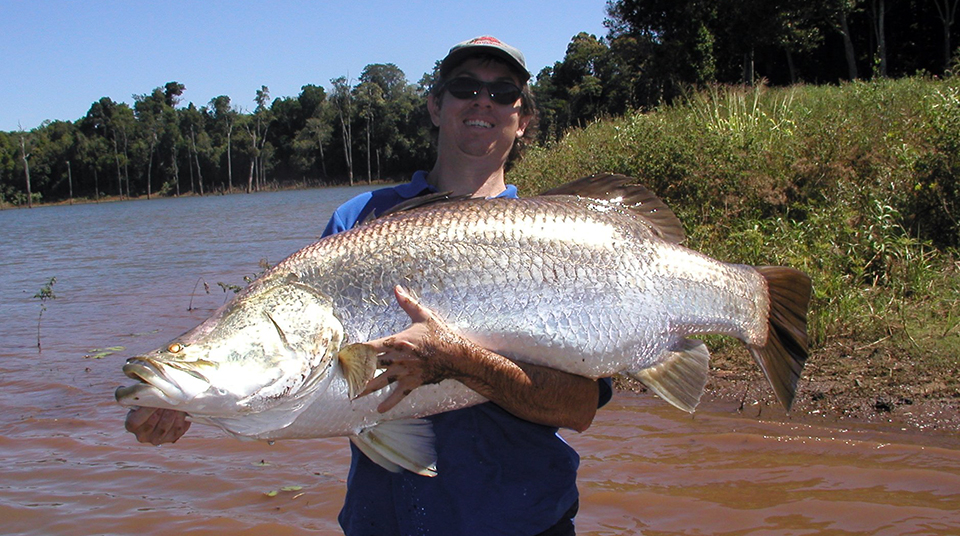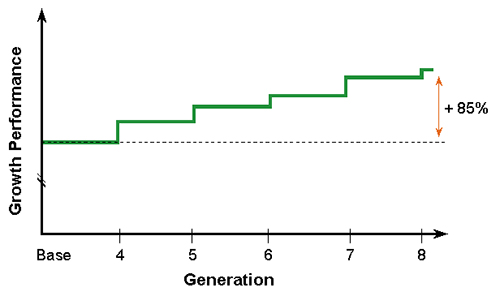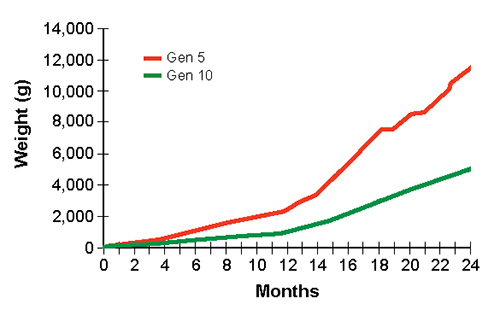Rate and duration of selection response directly proportional to genetic differences within populations

Classical selection of superior animals may be the most effective and appropriate method to genetically improve aquacultured marine fish. Past experience with salmon and tilapia suggest improvement rates of 10 to 20 percent per generation are possible. Accordingly, we can make certain predictions for as yet unimproved aquacultured species. Considering the barramundi as a model, we predict an improvement rate of 135 percent over the next 20 years, more than tripling the internal rate of return for farms, and allowing farmed fish to out compete wild fisheries.
Selective breeding
In “Genetic Improvement of Marine Fish – Methods, Values for Sea Bream, Other Species” – a previous article by the main author in the February 2002 issue of the Global Aquaculture Advocate, it was tentatively concluded that there are few exceptions where selective breeding – when tested against other genetic strategies – did not deliver the superior breeds. Only selective breeding and exploitation of the genetic differences within strains (additive genetic variance) have the capacity to deliver continual genetic improvement, and to do so deliberately (in a planned way) for a variety of different traits, simultaneously. Offsetting these desirable features of selective breeding are the disadvantages of cost, infrastructure, and perhaps most significant, a requirement for a long-term commitment and organization to prosecute a selective breeding program.
Past experience

Several large-scale selection experiments and breeding programs aimed at increasing growth rate were conducted in the last couple of decades, resulting in 10-20 percent gain per generation. The most impressive ones dealt with Atlantic salmon, (Salmo salar) (L.) and rainbow trout (Oncorhynchus mykiss) (Walbaum) (AKVAFORSK, Norway) and Nile tilapia (Oreochromis niloticus) (L.) (GIFT, Philippines).
These selective breeding programs resulted in 250 percent improvement in growth rate in the Atlantic salmon and in 85 percent improvement in the Nile tilapia. Although the Norwegian trout and salmon, and the GIFT Nile tilapia breeding programs have yet to be comprehensively and critically described in full details, the products from these breeding programs are commercially used by the industry. An evaluation of the performance of the GIFT Nile tilapia in comparison to local stocks has been performed in several Asian countries, resulting in varying degrees of superiority of the selected fish.
Prospects for unselected species
By making some assumptions, it is possible to predict economic and productivity returns from species that to date have not been selected. In the example considered here the giant Asian sea bass or barramundi (Lates calcarifer) is used in the context of the Australian industry, as a model to consider the consequences of selection. With rather long generation time (average of 3 to 4.5 years), predicted rates of improvement per year for barramundi will be rather conservative relative to species with shorter generation times.
Base population
The rate of selection response and its duration are directly proportional to the amount of genetic differences within populations. Hence, every reasonable effort should be made to establish a base population comprising different strains from different regions, and different individuals from each strain without compromising the overall merit of the base population, and the opportunity to include genes of major effects already identified in local strains.
Breeding objectives and criteria
One objective to consider is an increase in overall profit or improvement of any trait or combination of traits that contribute to profit. The criteria are the ways the traits are measured. Potential candidate traits for selection include growth rate, maturation age, feed conversion efficiency, fecundity, antagonistic behavior, male fertility, survival, disease resistance and meat quality. Growth rate is a prime candidate for selection, as it is economically important, easy to measure and responds to selection effort with improvements in feed efficiency.
Type of selection

Theoretical considerations suggest within family selection may be a reasonable compromise of the sometimes contradictory requirements for outcome-oriented selection programs, especially where it is difficult to reduce the environmental variance between families, and limited budgets are available. Indeed, within family selection may yield effective rates of response under industrial conditions greater than those from programs that theoretically would yield faster response.
Moreover, compared with other breeding designs, within family selection has various advantages, including:
- Requires little new infrastructure (families can be grown separately in different existing commercial ponds).
- Requires few families (e.g., 20).
- Spawning can be at different times for different families.
- There is little inbreeding (effective population sizes are 2x larger than for other designs).
- Incurs little cost for tagging and tracking of pedigrees.
Predicted returns and costs
Assuming selection of just growth rate without using information from other traits, or relatives, we calculate that a barramundi selective breeding program has the potential to improve growth rate by 135 percent over a 20-year period. This amounts to increased net present returns of A $1.5 million (U.S. $876,093) for each 50-ton production unit over the same period. For a large scale unit producing 1,000 tons annually, the returns from selection would amount to A $47 million (U.S. $27.4 million) net present value over a 20-year period. This would increase the internal rate of return for barramundi farming from 5.7 percent to 21 percent, and lower the break-even price from A $9.33 to $7.17 per kilogram (U.S. $5.45 to 4.19 per kilogram), making farmed barramundi more competitive than almost all wild harvested fish in Australia, and would subsequently reduce harvesting pressure and environmental impacts on natural ecosystems.
Assuming 20 years of selection were already realized, the new breakeven price would be equivalent to lowering production costs by 75 percent, provided selection continued. This would enable the development of potentially huge export markets and promote substantial long-term growth of the Barramundi farming industry.
The cost of implementing the selection program is estimated at A $400,000 (U.S. $233,625) giving a benefit-to-cost ratio of 11:1 (considering present size of industry). This may be conservative, as likely returns from improved feed conversion efficiency due to selection for growth were not included in the model. With a ten-fold increase in production supported through export markets, the benefit-to-cost ratio could exceed 50:1. These benefit-to-cost ratios are within the range estimated in other aquaculture species.
(Editor’s Note: This article was originally published in the February 2003 print edition of the Global Aquaculture Advocate.)
Now that you've finished reading the article ...
… we hope you’ll consider supporting our mission to document the evolution of the global aquaculture industry and share our vast network of contributors’ expansive knowledge every week.
By becoming a Global Seafood Alliance member, you’re ensuring that all of the pre-competitive work we do through member benefits, resources and events can continue. Individual membership costs just $50 a year. GSA individual and corporate members receive complimentary access to a series of GOAL virtual events beginning in April. Join now.
Not a GSA member? Join us.
Authors
-
Wayne Knibb, Ph.D.
Queensland Department of Primary Industries
Bribie Island Aquaculture Research Centre
144 North Street, Woorim
P.O. Box 2066
Bribie Island, Queensland 4507
Australia[117,97,46,118,111,103,46,100,108,113,46,105,112,100,64,98,98,105,110,107,46,101,110,121,97,119]
-
Michael Macbeth, M.S.
Queensland Department of Primary Industries
Bribie Island Aquaculture Research Centre
144 North Street, Woorim
P.O. Box 2066
Bribie Island, Queensland 4507
Australia -
Cam McPhee, Ph.D.
Queensland Department of Primary Industries
Bribie Island Aquaculture Research Centre
144 North Street, Woorim
P.O. Box 2066
Bribie Island, Queensland 4507
Australia -
Department of Aquaculture
Institute of Animal Science
Agricultural Research Organization
Volcani Center, Bet Dagan, Israel[46,68,46,104,80,32,44,97,116,97,108,117,72,32,105,100,105,71]
Related Posts

Health & Welfare
Genetic detection of bacteria improves selective breeding in channel catfish
Sensitive detection of enteric septicemia is important to the successful development of a selective-breeding program for ESC resistance.

Health & Welfare
Black tiger domestication, selective breeding advance in Australia
Using clear-water tank systems, CSIRO and a collaborating farm have advanced the domestication of black tiger stocks in Australia.

Health & Welfare
Applied commercial breeding program for Nile tilapia in Egypt
A major goal of selective breeding program for Nile tilapia (Oreochromis niloticus) in Egypt is to select for fillet color and fillet weight in response to consumer preferences.

Health & Welfare
Atlantic cod genomics and broodstock development project
The Atlantic Cod Genomics and Broodstock Development Project has expanded the gene-related resources for the species in Canada.


